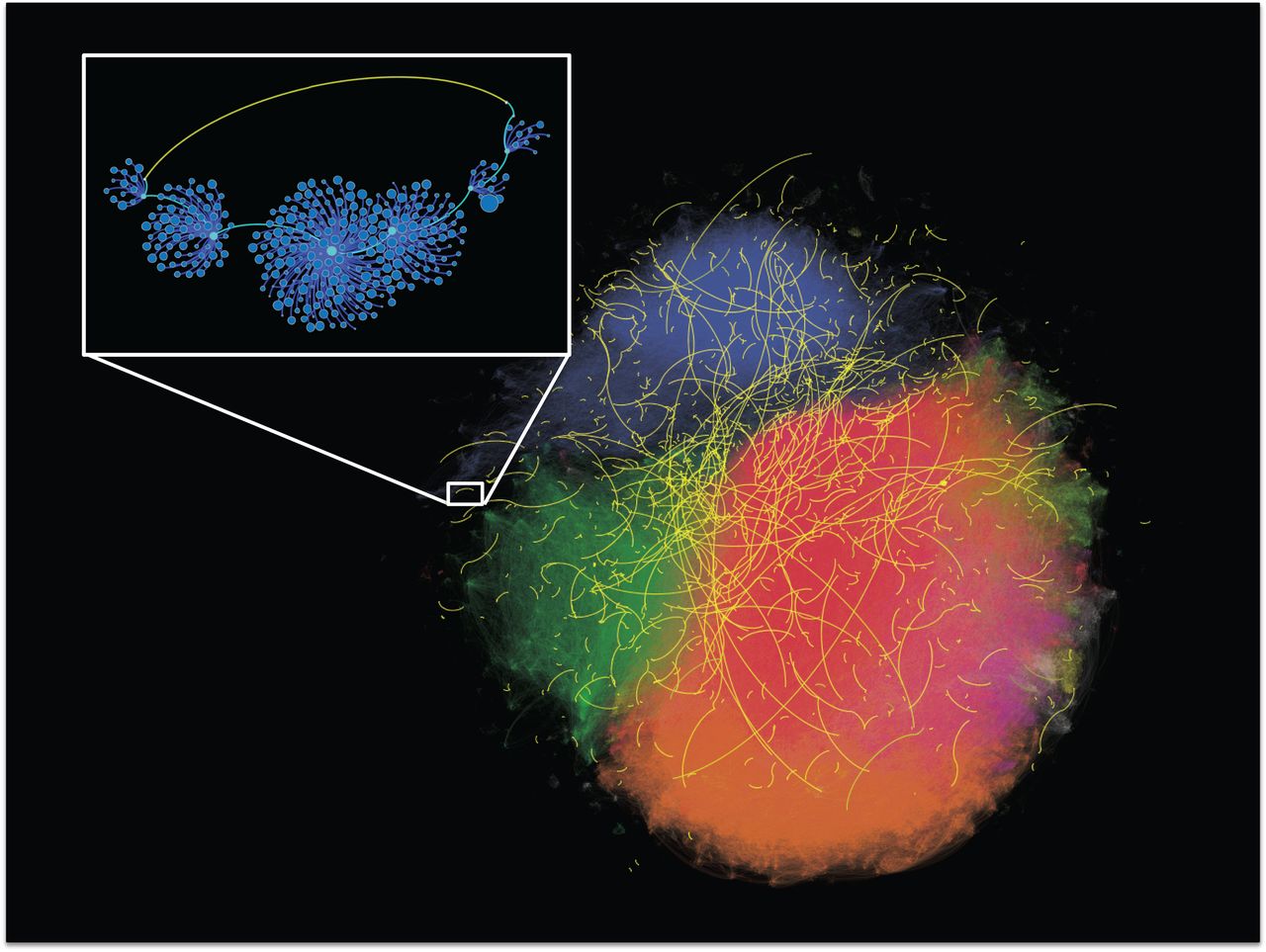
Network wormholes in Singapore’s Twitter network, from Park et al, Science 2018. “Each dot represents an individual, and each edge represents a bidirected @mention. Nodes and edges are colored according to membership in distinct network communities. A sample of network wormholes (with range six or above and above-median tie strength) is shown in yellow. The inset highlights a single wormhole of range eight, i.e., the second-shortest path between the yellow nodes requires traversing eight intermediary ties (blue edges). The sizes of the nodes in the inset are proportional to the number of network neighbors.”
Overview
Why does Linux and the broader open-source ecosystem thrive despite weak economic incentives? Why do complex software systems sometimes fail despite being well-engineered? What makes a social media recommendation algorithm so effective and so toxic at the same time? Why do YouTube mega-influencers with tens of millions of subscribers exist, yet each of us can only recognize a handful at best? How do echo chambers and polarization emerge in social media platforms? How can you land your dream jobs? How does mass adoption of technological innovations happen? Underlying these seemingly unrelated questions is the powerful influence of social networks, the collection of on- and offline connections and dependencies that people and systems form with one another, often unknowingly.
This course offers an introduction to the study of social networks and builds the skills needed to answer these wide range of questions by interweaving two threads. First, we introduce network science concepts and their mathematical and graph theoretical foundations, to give rigorous definitions to fuzzy words we use to describe the social world, such as “status” and “social group.” Second, we apply these network concepts hands-on, to statistically model and study a wide range of puzzling online social phenomena in real-world networks.
After completing this course, you will be able to:
- construct an adequate social network representation of a given social domain
- proficiently analyze network data, and
- interpret the results with socially meaningful insights
Coordinates
- Lectures: Tuesdays & Thursdays 2:00-3:20pm, Eastern Time, in Wean Hall 4708
- Assignments, private announcements, reading materials: Canvas
- Slides: this website
- Instructor: Patrick Park
- Office hour: Wednesdays 2:00pm-3:00pm or by appointment (TCS 324)
Course Syllabus and Policies
The syllabus covers course overview and objectives, evaluation, time management, late work policy, and collaboration policy.
Schedule
Below is a preliminary schedule for Fall 2025. The schedule is subject to change and will be updated as the semester progresses. For previous schedules, see Fall 2024.
| Date | Topic | Slides | Note |
|---|---|---|---|
| Tue, Aug 26 | Introduction | slides | |
| Thu, Aug 28 | Intro to graph theory | slides | Assignment 1 Posted |
| Tue, Sep 2 | Random networks | slides | |
| Thu, Sep 4 | Edges vs social ties | slides | |
| Tue, Sep 9 | Triads and structural balance | slides | Assignment 1 Due |
| Thu, Sep 11 | From social processes to graphs | slides | |
| Tue, Sep 16 | Homophily and degree correlation (part 1) | slides | |
| Thu, Sep 18 | Homophily and degree correlation (part 2) | slides | |
| Tue, Sep 23 | Power and centrality in social networks | slides | |
| Thu, Sep 25 | Power and centrality in social exchange | slides | |
| Tue, Sep 30 | Detecting communities | slides | |
| Thu, Oct 2 | Scale-free networks | slides | |
| Tue, Oct 7 | Affiliations and Overlapping Subgroups | slides | |
| Thu, Oct 9 | Midterm exam | ||
| Tue, Oct 21 | Network Visualization | slides | |
| Thu, Oct 23 | Small-world networks | slides | |
| Tue, Oct 28 | Social Capital (part 1) | slides | |
| Thu, Oct 30 | Social Capital (part 2) | slides | |
| Thu, Nov 6 | Social Dynamics on Networks: Information Diffusion and Social Contagion | slides | |
| Tue, Nov 11 | Guest lecture 1 (Bogdan Vasilescu) | slides | |
| Thu, Nov 13 | Guest lecture 2 (Bogdan Vasilescu) | slides | |
| Tue, Nov 18 | Ethical issues | ||
| Thu, Nov 20 | Structural Equivalence | ||
| Tue, Nov 25 | Opinion dynamics and polarization | ||
| Tue, Dec 2 | Graphs and machine learning | ||
| Thu, Dec 4 | Final Project Presentations |